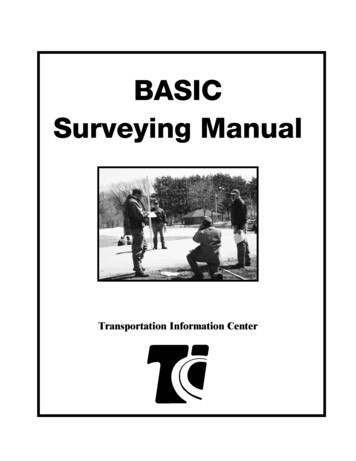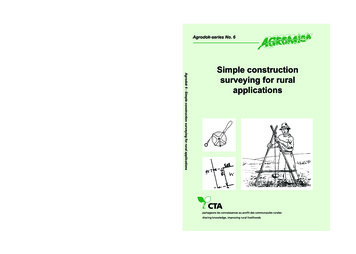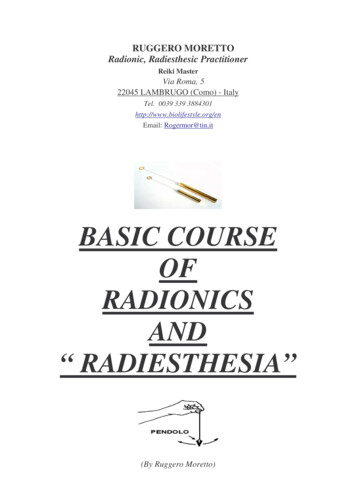
Transcription
BASICSurveying ManualTransportation Information Center
Contents PageMeasuring horizontal distances4 455671011PacingTapesHistorical surveyor’s chainTaping methodsHorizontal distancesStationingRight trianglesVertical measurements13 14162021242627EquipmentLeveling proceduresLevel exampleSurvey notesOne person levelingAdjustment of hand levelCommon leveling mistakesConstruction staking28 Stake markings Calculating cut and fill2830Slopes and grades31 Percent Ratio3132Field exercises, examples and solutions34This manual provides basic concepts about surveying and is intended for use in the training courseSurveying Methods for Local Highway Agencies. The manual and course are intended for town, village,city, and county personnel who have field responsibilities related to highway construction and maintenance.It is not intended for engineers, technicians, or surveyors with a background in surveying.This manual is patterned after the similar publication developed by the Cornell Local Roads Program withcontributions by Maine and several other LTAP Centers. We also want to acknowledge Paul Cooney, P.E.,L.S. for his valuable assistance in teaching workshops for the Transportation Information Center (T.I.C.).Donald Walker, T.I.C. Director, authorLynn Entine, Entine & Associates, editor Copyright November 2002Wisconsin Transportation Information Center (LTAP)432 N. Lake Street, Madison, WI 53706Phone: 800/442-4615Fax: 608/263-3160e-mail: tic@epd.engr.wisc.eduURL: http://tic.engr.wisc.edu2
Surveying manualSurveying is the science of determining the relative positions of objects or points on theearth’s surface. These points may be any physical thing: a highway, culvert, ditch, stormdrain inlet, or property corner. Distances and directions determine the horizontalpositions of these points. The vertical positions are determined by differences inelevations measured from a reference location known as a benchmark.This manual presents basic principles and practices of surveying for highwayconstruction and maintenance work. It discusses techniques for measuring horizontaldistances and vertical elevations, construction staking and slopes, and gives a number ofexamples and exercises.Accuracy is very important in survey work. Some points must be located to the nearest0.01 foot. Others may be located to the nearest whole foot horizontally and nearest 0.1foot vertically. Accuracy is also sometimes described in terms of a ratio such as 1/100(one in one hundred). This means the measurements should be accurate to within one footin 100 feet, or 10 feet over a distance of 1,000 feet, for example.Before choosing personnel and selecting survey equipment, it is important to determinethe accuracy required for the job. Cut and fill slopes and ditches, for example, don’trequire the same accuracy as drain inlets and finished pavement grades.No survey measurement is ever exact. Surveys are subject to error, so always check yourwork. It is better to take the time to do it right than having to find the time and money tocorrect mistakes.3
Measuring horizontal distancesHorizontal distances may be determined by many methods. The survey tape is the mostcommon, but other methods and devices are also used in highway work.- Pacing Count the number of steps and multiply by the known length of each step.This is used to provide distance estimates when no measuring device is available orprecision is not required. Experienced personnel may achieve a precision of 1/50.- Measuring wheel On this commercial device, distance is measured by eachrotation of a wheel and reported on a dial. It is commonly used to record distancessuch as curb length or paving quantities and can also be helpful for determiningdistances along a curve. Precision is usually 1/500- Odometer Vehicle odometers are helpful in determining long distances such as forsign layout or checking vision at intersections. Precision of 1/20 is reasonable.- Estimates Skilled people can often estimate distances with good results. This maybe sufficient for some purposes.- Electronic Modern surveying uses a variety of electronic equipment to measuredistances. This quickly provides very precise measurements but requires experiencedpersonnel and relatively expensive equipment. PacingPacing consists of counting the number of steps or paces in a required distance.Distances obtained by pacing are sufficiently accurate for many purposes in surveying.Pacing is also used to validate survey work and eliminate any taping blunders.Measuring your pace length requires a measured 100-foot distance. You then walk thisdistance and count the number of steps. It is best to repeat the process four times andaverage the results.It is possible to adjust your pace to an even three feet, but this should usually beavoided. It is very difficult to maintain an unnatural pace length over a long distance.Accurate pacing is done by using your natural pace, even if it is an uneven length suchas 2.6 feet. It is difficult to maintain an even pace when going up hill or down hill.Using your natural pace will make this easier.Another error can occur if you are not consistent in starting with either the heel or toeof your shoe. If you place your toe at the start point, then also measure the end pointwith your toe. Starting with the heel and ending with the toe is a common mistake.Some surveyors prefer to count strides. A stride is two steps or paces. This reduces thecounting but often requires using part of a stride to determine the total distance.Pacing is a valuable skill for surveyors. It requires some practice and concentration.Experienced pacers can measure distances within 1/50 to 1/100 in open and levelterrain.4
TapesTapes come in many different materials and styles.- Cloth Cloth tapes are common in construction surveys. They are 5/8 inch wide andmade of high-grade linen or plastic.- Metallic Metallic tapes are often either 50 feet or 100 feet in length and come onenclosed reel cases. Be careful when using metal tapes around electrical sources.- Builders tapes Builders tapes are often narrower and lighter than surveyor’s tapes.They are also often shorter and come in enclosed cases. They may be in feet andinches rather than hundredths of feet.- Surveyors/engineers tape These tapes are made of steel and are inch to 3/4 inchwide in 100, 200, and even 500 feet lengths. The 100-foot tape is common. Theymay be wound on an open or closed reel. Typically they are graduated at every footand marked from 0 to 100. Some subtracting tapes have only the last foot at each enddivided into tenths and hundredths. Others, called adding tapes, have an extragraduated foot beyond the zero mark. Historical surveyor’s chainEarly surveyors in Wisconsin used the Gunter Chain to measure horizontal distances.This came from England and is named after the inventor, Edmund Gunter. It consistedof an actual chain made of individual links. Early chains were wood; later ones weremade of iron.One Link .66'Figure 1: Surveyor’s ChainThe early surveyor’s chain used the English length of 66 feet. There were 100 links,each 0.66 feet in length. While 66 feet seems unusual, it was used to keep the earlychains from being too long and heavy. Sixty-six feet is proportional to our Englishmile and acre. There are 80 chain lengths to a mile, 40 chains to a half-mile, etc. Oneacre is measured as 10 chains long (660 feet) by one chain wide (66 feet), giving43,560 square feet.5
Acre 10 square chains66'10 chains 660'660' x 66' 43,560 sqft (acre)Figure 2: Surveyor’s ChainOther multiples of the chain are still in use today. A furlong, used in horse racing, is 10chains, or 660 feet. A rod is 1/4 of a chain or 16.5 feet. Rods are commonly used inearly highway right-of way descriptions. The Wisconsin Statutes still describe right-ofway as 3 or 4 rods. Taping methodsIt takes some skill to measure distances with a tape and produce accurate, consistentresults. The following suggestions help avoid errors and sloppy work:Reading the tape. The first, often overlooked, step involves a review of the tape. Tapesmay have several types of scales and gradations. First determine if the tape uses metricor English units. Then review the gradations. The most common surveying tape willhave gradations in feet and hundredths of a foot. Often the even footmarks are in redwith tenths marked in black numbers. The 0.05 gradation lines are usually longer thanthe hundredths (0.01) but shorter than the 0.10 marks.The end of the tape is another important item to inspect. You must locate the zeropoint. Some common cloth tapes have a hinged clip to aid in measuring distances byyourself. Often the zero point is at the end of the hinge. The point is to inspect and besure you know where the zero point is on the tape you are using.When measuring a long distance of several tape lengths you must take care in lining upthe measurements. An error is introduced if you do not measure in a straight line. Astraight line is maintained by having the rear tape person direct the forward tape personso that he or she is in line with the finish point (called “lining in”). A range pole orsome other device is used to mark the forward point. A considerable error can result ifyou are not careful to line in the measurements over a long distance.The tape must also be pulled tight when measuring a distance. Sagging will cause anerror. Wind is also a problem that causes additional error. A tension in the range of 10to 20 pounds is necessary. To maintain a steady pull, it is helpful to have leather thongson the tape ends. Wrap one hand around the thong, keep the forearms against the body,and face at right angles to the line. Good communication between head and rear tapepersons will avoid jerking the tape and will save time.6
Measuring over rough ground or areas of brush requires the tape to be held horizontalrather than laid on the ground. The tape is usually held near waist height and plumbbobs are necessary to mark the end points. The tape is marked by placing the plumbbob string over the proper tape graduation and securing it with one thumb. Survey pinsor stakes may be used to mark points. A mark on the stake top or a tack may be used tomark the points being measured.Errors from improper lining, sag, wind, or uneven ground result in measurements thatare too long; the recorded length is more than the actual distance. On the other hand,these errors cause the length between points being set in the field, to be short. Forexample, if the tape sag causes an error of 1 foot in a distance of 100 ft, then stakesbeing set 100 feet apart would only actually be 99 feet apart. If several of these factorsare present the error accumulates and can be substantial. Accurate taping requires skilland attention to detail. Horizontal distancesSurveying and highway construction practice use horizontal distances rather than slopedistances. This is necessary because the horizontal distance between two points doesnot change even if the ground is disturbed. If the surveyor used slope distances, thenthe distance between objects and places would change every time the grade changed.yyyyy;;;;;;;;;;yyyyy;;;;;yyyyyHorizontal distance HB90ºVerticaldistance VpeSlodisteanc SAGroundFigure 3: Horizontal distance measurementFigure 3 shows the relationship between horizontal and slope distance. The slopedistance is always greater than the horizontal distance. Obviously, the greater theslope, the greater the difference between horizontal and slope distance. If greatprecision is not required and the slopes are not steep, then you may use the slopedistance. Naturally it is easier to lay the tape on the ground than to use plumb-bobs tomeasure distances. Table 1 shows the effect of using slope distances for various slopes.7
TABLE IConverting Slope to Horizontal distancesHorizontal Distance if Slope is:Slope10 9.44447.211:17.0717.6835.3670.71353.55Plumb Line100 ft markon tapeHorizontal75 ft markon tapeTape30 ft markon tape0 ft markon tapeTaping on sloping ground often requires use of the “breaking tape” procedure. Where a100-foot length cannot be held horizontal without plumbing above chest height, youmust measure shorter distances. Figure 4 illustrates this procedure.Direction of Tapingis usually downhill30 ft45 ft25 ft100 ft horizontalFigure 4: Procedure for breaking tapeIn the example, the tape’s zero point is held at point A. The steep slope limits the firstdistance to about 30 feet. Measuring beyond this length required the tape to be heldabove the chest of the forward tape person. A point is set at 30 feet and the rear tapeperson moves to the 30-foot mark, with the tape on the ground. The forward tapeperson moves ahead until the tape is again about waist or chest high when held8
horizontal. In this example, the 45-foot mark is placed and the process is repeated forthe final segment. The individual measurements must be totaled for the finalmeasurement.If the total distance is likely to be less than 100 feet, then it is easier to let the tape dothe adding. Placing the 30-foot mark on the tape at the ground 30-foot point does this.Then the next point would read on the tape as 75 feet. This eliminates the need to totalthe individual distances.Taping downhill is preferable to uphill, because the rear point is held steady on theground, while the other end is plumbed. In taping uphill the forward point is set whilethe other end (being plumbed) may be wavering somewhat.9
StationingStationing is used to establish a reference in highway and building construction. Thisbase line or reference can then be used to locate features along and adjacent to the baseline.0 500 003 751 002 003 004 005 006 0050'100'375'Figure 5: StationingFigure 5 shows a typical centerline stationing. It may start at zero or, often, at 10 or100 to avoid negative stations during future surveys. The stationing or distanceincreases along the line. By convention, highway stations increase from west to eastand south to north.Stations are 100 feet apart. Points in between are measured from the last station andindicated as plus ( ) distances. For example, a point 32.5 feet ahead for station 10 iscalled 10 32.5The stationing (baseline) can also be used to locate features adjacent to the baseline.For example a culvert inlet may be described as being at station 26 78, 30 feet Rt.(right). This means the inlet is 30 feet right of station 26 78. The offset is measured ata right angle to the centerline (or baseline). One must face in the direction of increasingstations when determining right or left.10
Right trianglesAngles of 90 degrees, called right angles, are used commonly in surveying. Righttriangles, which have one 90-degree angle, have some unique characteristics that arehelpful to know and understand.5acb390º4c2 a2 b225 9 16Figure 6: Right triangleFigure 6 illustrates some of these properties. If we know the length of any two sides ofa right triangle, then we can calculate the length of the remaining side. This is knownas the Pythagorean theorem. To use this property, you must determine the square rootof a number, which is very easy with a hand calculator.It is also helpful to know the features of a special type of right triangle. If the sides aremultiples of the 3:4:5 triangle, then the calculations are made easy.You can use the properties of right triangles to set right angles from a baseline. Forexample to locate a feature from the centerline, you can establish a 15ft:20ft:25fttriangle as shown in Figure 7.11
15'20'25'Figure 7: Measuring right angleAnother, more approximate method, is sometimes used in the field. You can stand onthe centerline and point each hand in opposite directions down the centerline, thenclose your eyes and swing your hands together in front of you. Your hands will then bepointing approximately at right angles from the centerline.12
Vertical measurementsVertical distances are measured from a point ofknown elevation called a benchmark. On localsurveys the benchmark is usually set at an arbitraryelevation such as 100.0. On surveys for largeprojects the benchmark will likely be a federal, stateor county benchmark. The US Coast Survey andGeodetic Survey have established a system ofpermanent benchmarks throughout the UnitedStates. These are made of concrete or steel with abrass disk on the top. The location and elevation arestamped on the disk.Elevations on federal or state benchmarks will berelated to average sea level. The marked elevation isthe vertical distance from average sea level to thetop of the benchmark. For example elevations inMadison, Wisconsin, are about 850.0 feet.In setting local project benchmarks it is highlyrecommended that you make the arbitrary elevationlarge enough so that there is no need to use negativenumbers in any part of the project. Negativeelevations can be used, but they only complicate themath. An arbitrary benchmark elevation of 100.0 iscommon and works well as long as no part of theproject is more than 100 feet below the benchmark.Figure 813
EquipmentLevel rods are used to measure vertical distances. They are available in English ormetric units. The English unit rods may divide feet into either hundredths or inches.Highway projects may use either English or metric level rods have several features tomake reading easier. The footmarks are in large red numbers and may be repeated inseveral places as a small red number. This helps because the level sight is often smalland shows only several tenths of the rod at a time.Level rods in hundredths use alternating white and black bars for each one-hundredth(0.01). Every five one-hundredths (0.05) has a bar with a chisel point end. Therefore,every even tenth point and intermittent five-one-hundredth point also has a chiselpoint.It is essential that the level rod be held in a “true” vertical position, since it ismeasuring a vertical distance. If the rod is leaning, then the reading is not actually thetrue vertical distance. Leaning the rod forward, backward, or to the side will cause anerror. Keeping the rod “plumb” is the rod person’s job because the person reading themeasurements cannot readily tell if the rod is leaning.14
The hand level is a simple and inexpensive device. It is sufficient for manyconstruction projects where great accuracy or long distances are not involved.Bubble tubeGlass withcross-wire scribingBubble tubeHalf-mirorField of viewFigure 9: The hand levelThe hand level is normally not magnified. It provides a line of sight with a bubble levelattached. The observer sees the target and level bubble at the same time. The rodreading is made using the crosshair when the bubble is centered. Bracing the handlevel on a staff or lath will make it much easier to steady and read.15
Leveling procedureThe hand level and rod are used to establish and verify elevations. If you only want todetermine the difference between two points, then you can make two direct readings asshown in Figure 10. The difference in rod readings (one subtracted from the other) isthe difference in elevation between the yyyyyLevel RodHorizontal Line of Sight7.212.63Level RodDiff. in Elev.Suveyors'LevelFigure 10If more than two points are involved, then a leveling procedure is used. The procedureinvolves starting at the benchmark, establishing the height of the instrument, and thentaking rod readings on points where new elevations are to be established. Figure 11illustrates the procedure.16
Backsight (plus sight)5.00B M ELEVATION 100.00'Height of instrument(HI)100.00'Plus sight ( ) 5.00HI 105.00'Figure 11: BacksightThe back sight, an elevation reading to a known benchmark, allows you to calculatethe height of the instrument. The term height of instrument means the height of theobserver’s eye when using a hand level.17
Foresight (minus sight)yyy;;;;;; ;;yyyyyHeight of instrument (HI) 105.0012'' culvert10.0'Culvert invert (inv)Elevation top 12" culvertH.I. (Eye level)!105.0'Minus sight (-)!10.0'Elev. top!!95.0'Elevation culvert invert (bottom)Elev top! 95.0'(-)!Invert!1.0' (12" culvert)94.0'Figure 12: ForesightWhen the level rod is next placed on a new point as shown in Figure 12, we can thencalculate the elevation of this point. The elevation is calculated by subtracting theforesight rod reading from the height of instrument. A foresight is the elevation readingof a point of unknown elevation.18
The rod could be moved to other points as shown in Figure 13, and similar calculationswould determine the elevations of these points.yyyy;;;;yyyyyy;;;;;;;;;;yyyy;;;;yyyyHI 105.003.06.0102.07.099.010.098.095.0Figure 13: Level side shots19
Leveling exampleMost construction projects require covering an area too big to be done from a singleinstrument setup. The example below shows how to carry the elevations to otherlocations.The example in figure 14 starts with a known project benchmark of 100.0 (a spike in atree). We want to determine the elevation of two other points TP1 and TR2. Surveyorsuse the term “turning point” (TP) for new points they use when carrying elevations tonew locations.yyyyyyyyy;;;;;;;;;;;;;;;;;;yyyyyyyyyHI B.S 9.7HI F.S 4.8B.S 6.1F.S 5.5100.00T.P. 2B.M. 100.0T.P. 1Figure 14The surveyor sets up between the benchmark (BM) and TR1. A back sight (6.1) is taken tothe BM. This lets you calculate the height of instrument (HI) as 106.1. The surveyor thenturns and takes a foresight reading on TR1 of 5.5. This permits calculating the elevation ofTP1 as 100.6.The surveyor then moves forward to a location between TP1 and TP2. A backsight readingon TP1 is 9.7. This allows a calculation of the new HI of 110.6 (100.6 9.7 110.3).The surveyor then turns and takes a foresight reading on TP2 of 4.8. This allows thecalculation of the elevation of TP2 as 105.5 (110.3 – 4.8 105.5)This procedure can be repeated to establish the elevation of other points. It is good practiceto complete the level circuit by returning to a known benchmark. This could be anotherknown project benchmark or back to the original benchmark. The surveyor will calculatethe elevation of the benchmark just as though it is a new point. Then compare the calculatedelevation with the known elevation. Hopefully they will be the same or within the accuracyrange for the project. This checking technique will assure that there are no blunders or grossmistakes. If the check elevation varies more than acceptable tolerance for the project, thesurveyor should redo the survey work until it checks correctly.20
Survey notesIt is essential that the surveyor take clear field notes. This reduces mistakes and allowsothers to use the notes for future surveys. The format shown below is standardsurveying technique.Field NotesPointB.S. BM6.1H.I.F.S.-Elev.100.0106.1T.P. 19.75.5100.64.8105.5110.3T.P. 2Figure 15Field notes are arranged in five columns. Column 1 is for a description of the featurebeing surveyed. For example the benchmark (BM), turning point (TP), culvert invert,ditch bottom, etc.Column 2 is for the back sight (BS). This is always a reading on a point of knownelevation. The column heading has a plus ( ) sign. This indicates the surveyor shouldadd this reading to the benchmark elevation in order to calculate the height ofinstrument (HI).Column 3 is the height of instrument (HI). It is calculated from the BS reading.Column 4 is the foresight (FS) reading. This is a rod reading taken on a point ofunknown elevation. The column heading has a minus (–) sign. This indicates thereading is to be subtracted from the HI to calculate the elevation of the point.Column 5 is the elevation of the point. It is calculated from the HI minus the FS.Figure 10 shows a common placement of figures in the field notes. The HI is oftenplaced a line below the BS. This makes it easier to find the HI. One can also visualizethat the HI is located between the BS and the next FS point.An alternate is shown in Figure 15. This option has the back sight (BS) placed in theline below (next to the HI). Some find this easier because it indicates the BS is taken tocalculate the HI and avoids two readings shown for one point.21
Alternate Field NotesPointB.S. 1T.P. 19.75.5100.64.8105.5110.3T.P. 2Figure 1622
yyyyyyyyy;;;;;;;;;;;;;;;;;;yyyyyyyyy100.00T.P. 2 105.5T.P. 1 100.6B.M. 100.0Figure 17The leveling procedure will establish elevation at points of interest on project. Theexisting elevations can then be compared to finished grade elevations on a gradingproject. The required cut on fill is the calculated for each point of interest.In the example in Figure 17 the existing elevations are noted. The field notes belowcan be used to calculate the required cut on fill as shown.PointB.S. BM6.1H.I.F.S.-Elev.FinishedGrade.Cut (fill)100.0106.1T.P. 19.75.5100.6101.0F 0.44.8105.5104.0C 1.5110.3T.P. 2Figure 1823
One Person LevelingThere is often a need for one person to accomplish field surveying tasks. Examplesinclude placing grade stakes, equipment operators resetting stakes during construction,etc. This requires special techniques, but many tasks can be accomplished alone oncethe surveyor understands the basics.One person cannot both hold a level rod on a distant point and take the elevationreading. Therefore the normal technique involves marking a known elevation with aline on a lath. In Figure 19 for example, a line is marked 3 feet above the known pointof elevation. We now know this line is 3 feet above the known elevation.Then the surveyor moves to a new location and rests the hand level along side the levelrod and shoots back at the marked lath. The hand level is adjusted until it is level withthe marked line on the lath. The height of the hand level on the level rod is then noted.For example the hand level is at the 5-foot mark on the level rod, when it matches theline on the lath. For the example in figure 12 we now can calculate that the bottom ofthe level rod is 2 feet below the elevation of the point at the lath.yyyyyyyy;;;;;;;;;;;;;;;;yyyyyyyyLevel RodHand Level3.0Rod ReadingA.B.Figure 1924
Figure 20 illustrates another example. To determine the difference in elevationbetween points A and B, the lone surveyor marks the lath 2.0 feet above point A. Thereading on the level rod is 4.6 feet when the hand level line of sight is on the markedlath. The difference is calculated as 2.6 feet. Therefore the elevation at point B is(89.0-2.6) 87.3 feet.yyyyyyyy;;;;;;;;;;;;;;;;yyyyyyyyy;Figure 20Difference in elevation (4.6-2.0) 2.6’Figure 21 shows the staking of the shoulder and ditch grade by using the centerlinegrade. Assume the existing centerline is at finished grade and the shoulder and ditchgrades are to be lower by the amounts in Figure 21. The lone surveyor starts by makinga lath at the centerline as 2.5 feet above the centerline. With the level rod reading at theshoulder of 2.3, we know the existing ground at the shoulder is 0.2 feet higher than thecenterline. Therefore, we need to mark the grade stake with a cut of 0.5 feet (0.2 0.3).In the same manner the cut marked at the ditch is (2.0-0.5) 1.5 shoulder2.5'CLFigure 21Want shoulder to be 0.3’ below centerlineWant ditch to be 2.0’ below centerline25
Adjustment of hand levelLevels may go out of alignment. Use the following procedure to check and adjust ifnecessary. Two people are required for this procedure.Start with a pole or post, called pole 1 in Figure 22. Mark a point A and take a levelreading with the level held on point A. Mark the level reading at point B on pole 2.Then move the level to pole 2. Hold the level on point B and shoot back at pole 1. Ifthe level is in alignment, then the reading will be on point A and no adjustment isneeded. If however the sight is not through point A, then mark the point as C. Adjustthe level so that the sight from point 2 goes through a point half way between points Aand C. This new point D is level with point B.A.LevelD.B.yyyyyyyy;;;;;;;;;;;;;;;;yyyyyyyyC.20' to 30'Pole 1Pole 2Figure 2226
Common leveling mistakesCommon mistakes made while leveling are summarized below along with steps toavoid mistakes.- Reading the wrong footmark Always read up from the footmark below. If thefootmark below is not visible, have the rod person raise the rod slowly.- Rod section skipped Pull all out sections of the extendable rod fully before starting.- Rod not vertical Stand directly behind the rod. Hold the rod with two hands, lightlygrip and balance the rod with both hands.- Rod held on wrong point Communicate clearly to rod person exactly where toplace rod.- Other tips·· Try to set up so as to read at least one foot above surfaces that are warm to avoidheat waves.· Set up to keep sights as short as possible.· Set up to keep back sights and foresights nearly equal in length.· Use solid benchmarks that can be easily found by others. Examples include: top nuton a fire hydrant, sewer inlet, top of curb with a chisel mark, spike in tree or pole,etc.27
Construction stakingStakes and lath are used to mark location and elevations (grades) in the field. They are avery important communication tool between the designer, the surveyor and thecontractor. Practices in marking stakes will vary between agencies. Therefore, thesurveyor must determine what practice is preferred and understood by others involved inthe project. The information below is common on many projects. Stake markingsThere are four basic parts to marking grade stakes:25'10'10'LTRTLT1 002 347 50.7C -3'F -2'INV. CulvertCB #CL roadFigure 23: Marking stakes28
- Station The stake is located along the reference or
6 Acre 10 square chains 10 chains 660' 66' 660' x 66' 43,560 sqft (acre) Figure 2: Surveyor’s Chain Other multip










